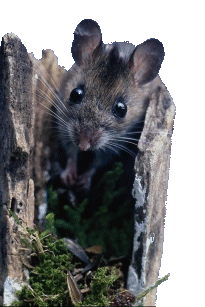The Deer Mouse
Remarks: The deer mouse is found throughout Alberta and indeed can be found all over North America. It can be found in forests, prairies, and deserts, but is not found where the ground is continually wet. Deer mice do not usually occur in urban areas. Their natural habitat is in rural and semi-rural areas, where they inhabit fields, pastures, and various types of vegetation found around homes and outbuildings. The deer mouse builds a spherical nest by shredding materials such as bark, grass, hair, string, and the fluff from cattails into a soft, warm bed with one main entrance. The nesting site can be found anywhere there is a cavity or opening such as under rocks or wood piles, or in empty bird's nests. Deer mice drop their scats and urinate in and around the nest site. Because of this there should always be a concern about Hantavirus when ever the deer mouse is found in sheds, attics, feed bins, or other enclosed spaces were people may breath the dust from the nest. Breeding starts very late in the winter and young are then born in April, they have many litters each from 2 to 9. On average, the deer mouse has about four litters each year. The gestation period varies from 22 to 27 days, averaging about 24 days. Litter size ranges from one to nine, averaging about four. At birth the young are blind, pink, and hairless and weigh from 1.1 to 2.3 g. The male while not present at birth, does return to assists in the care of the young. Sexual maturity is reached before the young lose their "blue" juvenile pelage, and females born early in the year may themselves produce young by late summer or early fall.
|
|||||||||||||||||||||

